
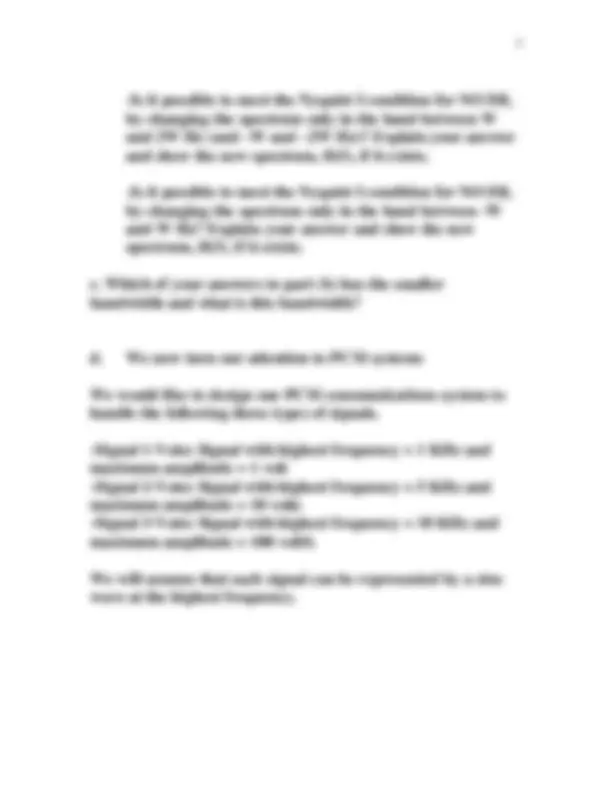
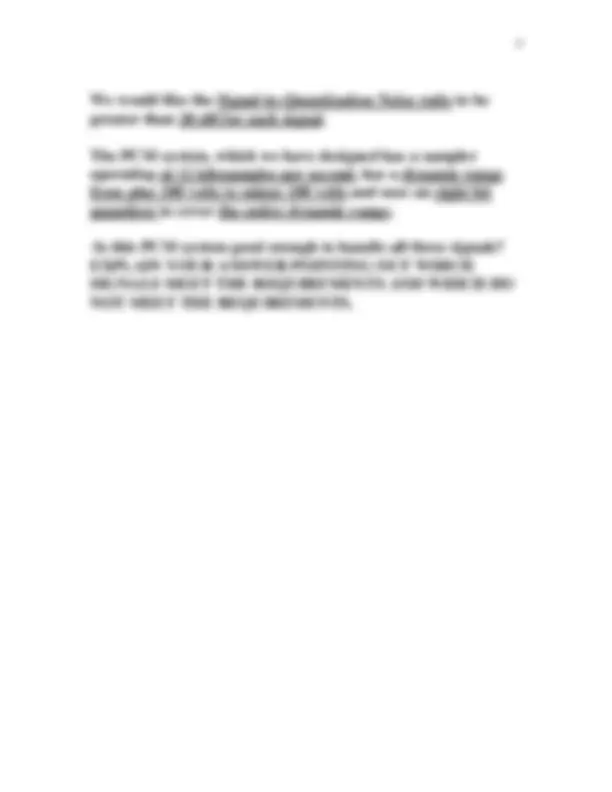
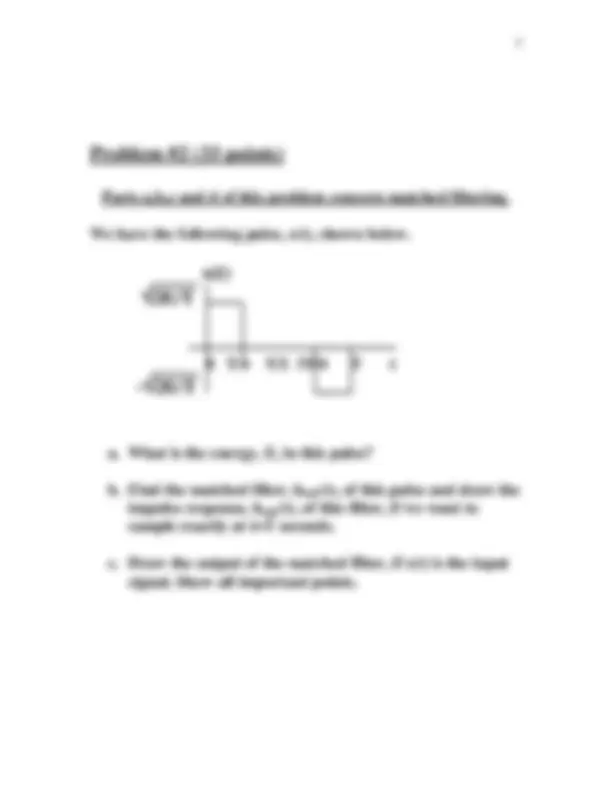
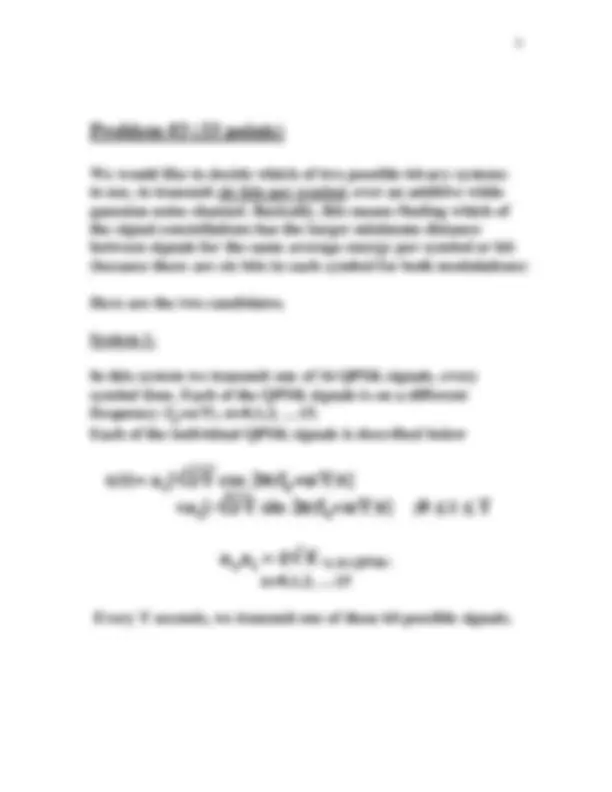
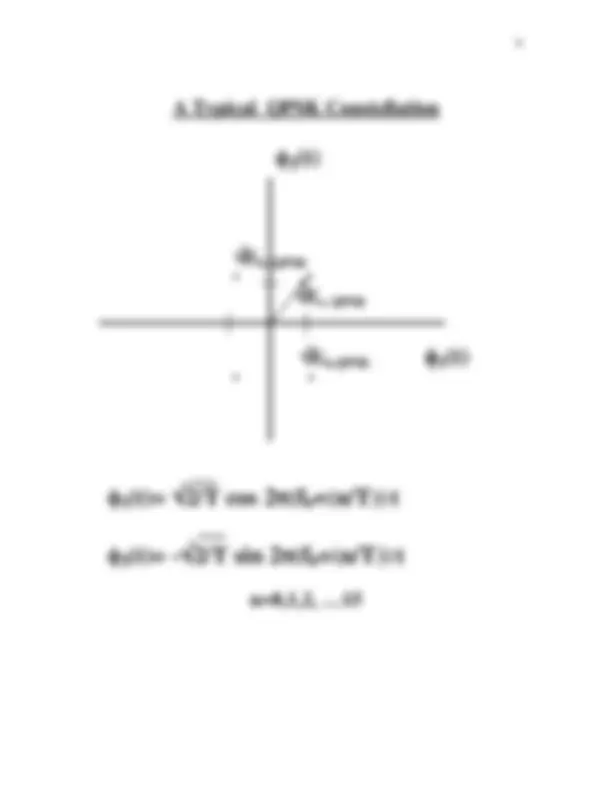
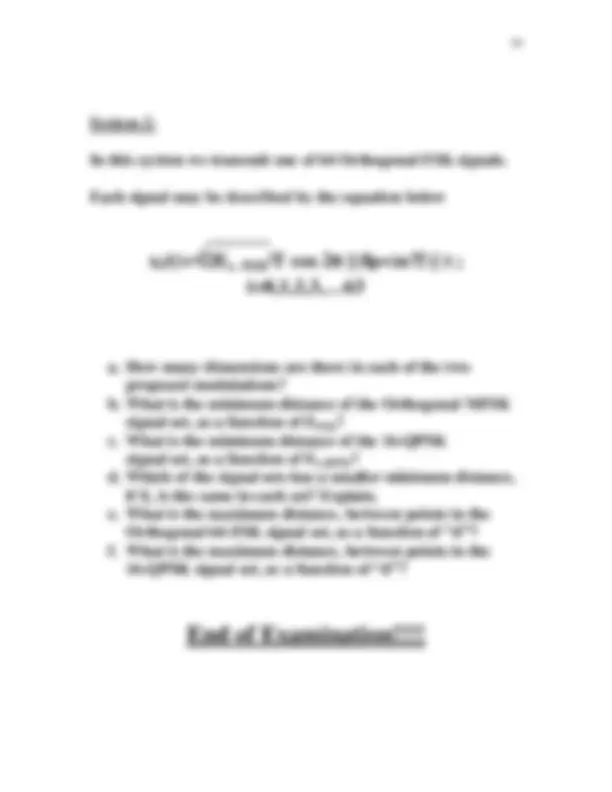
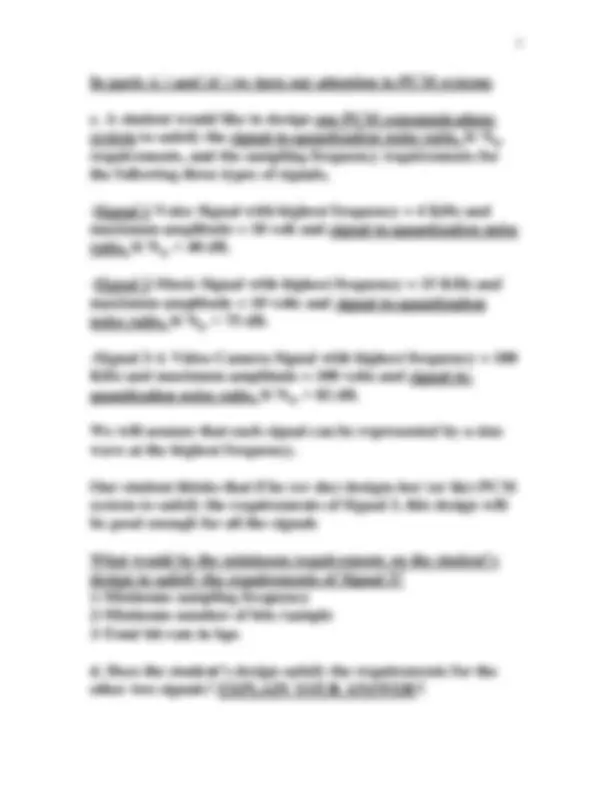

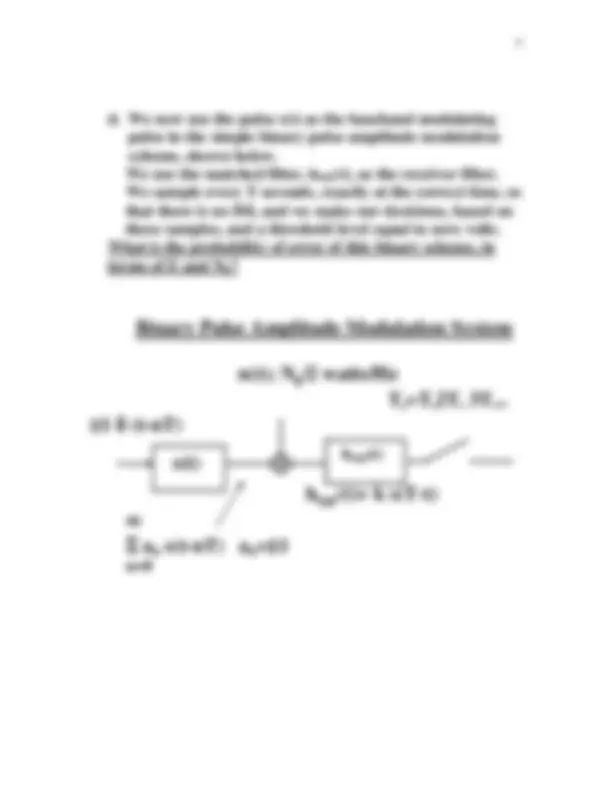
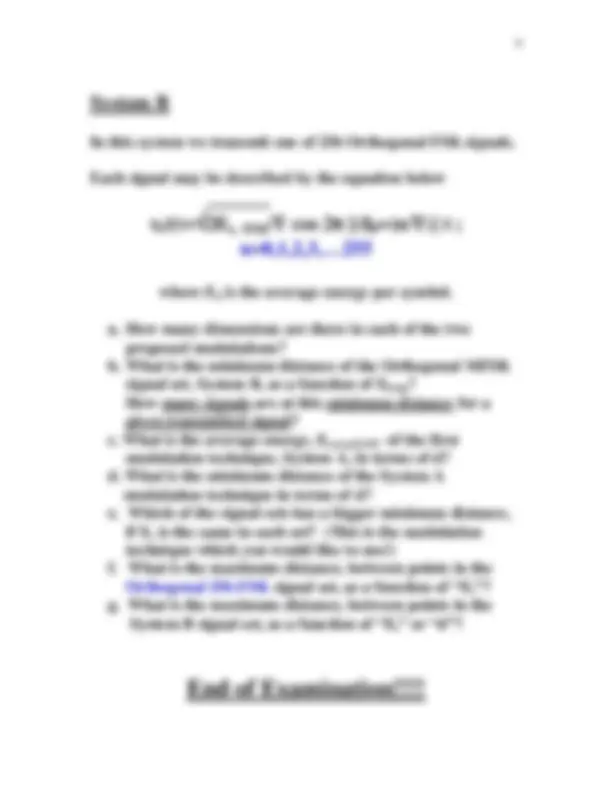


Study with the several resources on Docsity

Earn points by helping other students or get them with a premium plan


Prepare for your exams
Study with the several resources on Docsity

Earn points to download
Earn points by helping other students or get them with a premium plan
Community
Ask the community for help and clear up your study doubts
Discover the best universities in your country according to Docsity users
Free resources
Download our free guides on studying techniques, anxiety management strategies, and thesis advice from Docsity tutors
Digital communication final exam for students and teachers and other that need to learn more about it go ahead and lookforward until fart so that you can load 1 docs or maximum 2 or something like this
Typology: Exams
1 / 18

This page cannot be seen from the preview
Don't miss anything!











A pulse, s(t), has the spectrum shown below
-2/3 W 2/3 W -2W -W 0 W 2W f
a. Does this spectrum satisfy the Nyquist I Condition for NO ISI? Explain your answer.
b. We are allowed to add on (or subtract) energy to this signal spectrum either in the frequency band
1- Between W and 2W Hz (and –W and –2W Hz),
or in the band,
2- Between –W to +W Hz, to create a new signal spectrum, H(f).
We would like the Signal-to-Quantization Noise ratio to be greater than 20 dB for each signal.
The PCM system, which we have designed has a sampler operating at 12 kilosamples per second, has a dynamic range from plus 100 volts to minus 100 volts and uses an eight bit quantizer to cover the entire dynamic range.
-Is this PCM system good enough to handle all three signals? EXPLAIN YOUR ANSWER POINTING OUT WHICH SIGNALS MEET THE REQUIREMENTS AND WHICH DO NOT MEET THE REQUIREMENTS.
Parts a,b,c and d of this problem concern matched filtering.
We have the following pulse, s(t), shown below.
0 T/4 T/2 3T/4 T t
a. What is the energy, E, in this pulse?
b. Find the matched filter, hMF(t), of this pulse and draw the impulse response, hMF(t), of this filter, if we want to sample exactly at t=T seconds.
c. Draw the output of the matched filter, if s(t) is the input signal. Show all important points.
Part (e) below concerns binary modulations using optimum decision making at the receiver.
e. In some BPSK systems, a small amount of power is sent on a SINE carrier to ease the phase synchronization problem at the receiver. In these systems, the two signals which are transmitted are either
x 1 (t)= k √2Eb/T cos 2πf 0 t + √(1-k^2 )[-√2Eb/T sin 2πf 0 t] or
x 2 (t)= - k √2Eb/T cos 2πf 0 t + √(1-k^2 )[-√2Eb/T sin 2πf 0 t]
for ;0 ≤ t ≤ T
0 ≤ k ≤ 1
2-What will be the probability of bit error as a function of Eb/N 0 , and k, for this system, if we use the optimum decision making criterion at the receiver?
3-What is the probability of error for k=1 and what is the probability of error for k=0?
We would like to decide which of two possible 64-ary systems to use, to transmit six bits per symbol, over an additive white gaussian noise channel. Basically, this means finding which of the signal constellations has the larger minimum distance between signals for the same average energy per symbol or bit (because there are six bits in each symbol for both modulations)
Here are the two candidates.
System 1-
In this system we transmit one of 16 QPSK signals, every symbol time. Each of the QPSK signals is on a different frequency (f 0 +n/T), n=0,1,2, …15.
Each of the individual QPSK signals is described below
n=0,1,2, …
Every T seconds, we transmit one of these 64 possible signals.
System 2-
In this system we transmit one of 64 Orthogonal FSK signals.
Each signal may be described by the equation below
a. How many dimensions are there in each of the two proposed modulations? b. What is the minimum distance of the Orthogonal MFSK signal set, as a function of EFSK? c. What is the minimum distance of the 16-QPSK signal set, as a function of Es,QPSK? d. Which of the signal sets has a smaller minimum distance, if Es is the same in each set? Explain. e. What is the maximum distance, between points in the Orthogonal 64-FSK signal set, as a function of “d”? f. What is the maximum distance, between points in the 16-QPSK signal set, as a function of “d”?
End of Examination!!!!
In parts (c ) and (d ) we turn our attention to PCM systems
c. A student would like to design one PCM communications system to satisfy the signal-to-quantization noise ratio, S/ Nq, requirements, and the sampling frequency requirements for the following three types of signals,
**- Signal 1-Voice Signal with highest frequency = 4 KHz and maximum amplitude = 10 volt and signal-to-quantization noise ratio, S/ Nq, > 40 dB.
-Signal 3-A Video Camera Signal with highest frequency = 100 KHz and maximum amplitude = 100 volts and signal-to- quantization noise ratio, S/ Nq, > 82 dB.
We will assume that each signal can be represented by a sine wave at the highest frequency.
Our student thinks that if he (or she) designs her (or his) PCM system to satisfy the requirements of Signal 3, this design will be good enough for all the signals
What would be the minimum requirements on the student’s design to satisfy the requirements of Signal 3? 1-Minimum sampling frequency 2-Minimum number of bits /sample 3-Total bit rate in bps
d. Does the student’s design satisfy the requirements for the other two signals? EXPLAIN YOUR ANSWER!!
This problem concerns matched filtering.
We have the following pulse, s(t), shown below.
0 T/4 T/2 3T/4 T t
- √ 2E/T
a. What is the energy in this pulse?
b. Draw the matched filter, hMF(t), of this pulse if we want to sample at time “t” equal to “T” seconds.
c. Draw the output of the matched filter, if s(t) is the input signal. Show all important points.
We would like to decide which of two possible 256-ary systems to use, to transmit eight bits per symbol, over an additive white gaussian noise channel. Basically, this means finding which of the signal constellations has the larger minimum distance between signals for the same average energy per symbol or bit (because there are six bits in each symbol for both modulations)
Here are the two candidates.
In this system we transmit one signal from one of sixteen 16- QAM signals, every symbol time. Each, of the 16-QAM signal sets, is on a different frequency (f 0 +n/T), n=0,1,2, …15.
Each of the individual 16-QAM signal sets is described below
n=0,1,2, …
Every T seconds, we transmit one of these 256 possible signals.
dmin
d/2 3d/
φ 1 (t)= √ 2/T cos 2 π (f 0 +(n/T)) t
φ 2 (t)= - √ 2/T sin 2 π (f 0 +(n/T)) t